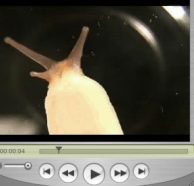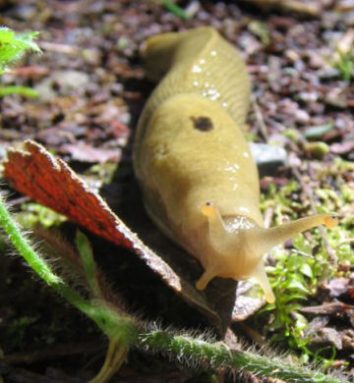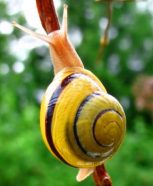Slip sliming away
Scientists study how slime helps slugs and snails get around on only one foot.
By Emily Sohn
Slugs and snails produce slime that looks a lot like the stuff that comes out of your nose. These creatures don’t use tissues to wipe up their snot, though. Instead, they use the goo to help them stick to surfaces and crawl over obstacles.
For years, scientists have been studying slug slime to better understand what it’s made of and how it works. Recently, researchers at the Massachusetts Institute of Technology (MIT) in Cambridge created a robotic slug that crawls on slime, just like real slugs do.
The research has attracted the attention of oil companies and other industries. Robotic snails and slugs, some engineers think, could be helpful tools for underground exploration.
 |
|
Slugs like this one use slime to stick to and crawl on slippery surfaces.
|
| iStockphoto |
“When I first started doing this work, I thought, ‘Who in the world is going to want a robotic snail?'” says Annette “Peko” Hosoi, a mechanical engineer at MIT.
“It turns out this kind of locomotion is very versatile,” she says. These creatures “can climb over any terrain—bark, sand, glass, walls, anything.”
Slugs and snails (no puppy dog tails)
Though snails have shells and slugs don’t, the two groups of animals are closely related and have a lot in common. Both are really good at sticking to slippery surfaces, such as wet leaves or rocks that get pounded by waves. And both have come up with an identical solution to a difficult problem: how to get around on only one foot.
If you looked closely at a slug or snail stuck to a glass aquarium wall, you’d see dark bands moving along its body. These bands are created by wavelike contractions of muscles in the animal’s single foot, and those rippling waves allow the creature to crawl.
 |
|
As a slug crawls on a glass surface, you can see the rippling motion of its contracting foot muscle. To see a video of this motion, click here or on the image above. (17 MB .AVI file; broadband connection recommended)
|
|
Annette Hosoi.
|
Decades ago, scientists realized that, along with this rippling motion, slugs and snails secrete slime as they move. Together, those two strategies allow the animals to get around, says Mark Denny, a biomechanic at Stanford University’s Hopkins Marine Station in Pacific Grove, Calif.
Time to study slime
In the 1970s, Denny started studying the slime of banana slugs, a type of slug that can be bright yellow (which explains its name). These creatures, it turns out, produce loads of the slippery goo.
Banana slug slime is “the snottiest stuff around,” Denny says.
 |
|
Banana slugs, like this one, have some of the snottiest slime in the slug family.
|
| Wikipedia/Courtesy of Jerome Charaoui |
Denny’s early research showed that slug slime is similar to the mucus that lines our lungs and comes out of our noses when we’re sick. Through their feet, the animals secrete proteins and sugar molecules that mix with water and give slime its unique properties.
Slime is 96 percent water. That’s why you’ll often see slugs and snails when it’s damp or rainy outside. They use water from the environment to make slime, which acts as a slippery highway on which they cruise.
Like mayonnaise, slug slime can form solid glops that hold their shape. When a slug isn’t moving, it anchors itself to surfaces by the solid form of its slime. But when slime is walked on by a crawling creature, it becomes liquidlike and slippery. Jell-O has similar properties.
Slug slime, however, can do something that Jell-O and mayonnaise can’t. After being smeared from a solid to a liquid, it can rearrange its molecules and re-form into a solid, once the slug stops moving on it. That property allows the animal to move and to stick to surfaces at the same time.
 |
|
Snails secrete a unique mixture of proteins that combine with water in the environment to make sticky slime.
|
| Wikipedia/Courtesy of Mad Max |
Here’s how it works. When the animal wants to go somewhere, it starts sliding the back end of its foot. The sliding motion makes the slime underneath that section slippery, and that section can then move forward.
When the rear end of the foot stops moving, the slime underneath it turns solid, making it stick. At the same time, a section of foot just in front of the rear section starts to move, creating slippery slime, which pushes that part of the animal forward.
In this wavelike way, the slug creeps forward, with just one part of its foot moving at a time. Slowly but surely, the animal gets where it’s going, even when it’s upside-down—thanks to slime.
Roboslug to the rescue
Engineers at MIT realized that moving like a slug could be useful in a variety of situations. So, they decided to see if they could build something sluglike that could stick to and move on all sorts of surfaces.
To better understand the creatures’ locomotion, Hosoi and her colleagues first videotaped slugs and snails as they crawled. After carefully analyzing the tapes, the scientists were able to build a robot that moved on artificial slime like a slug moves on real slime.
The researchers used a human-made material called Laponite to mimic slime for the robot. Laponite, which is made of clay particles suspended in water, can switch between solid and liquid, just like slug slime does.
 |
|
This robot may not look like a snail or slug, but it moves a lot like one of those slime-producing creatures.
|
| Annette Hosoi |
 |
|
|
| Annette Hosoi |
Unlike a real slug, which has just one foot, the robotic slug above has six footpads. When placed on a Laponite-coated surface, the robot moves one footpad at a time, starting with the rear foot and moving forward. The footpad that is moving slips along liquefied slime. The others remain stuck to solidified slime.
Like real slugs, the robotic slug can climb up walls and across ceilings. The robot’s motion is not as smooth as that of a real slug, but the overall pattern is the same.
Robotic slugs might some day help hunt for oil buried in the earth, crawling up and down muddy holes without slipping, Hosoi says. Eventually, doctors might send tiny robotic slugs into the human body for medical research and treatment.
Slime researchers hope their work will inspire more respect for a substance that isn’t often appreciated.
“People have an aversion to slime,” Denny says. “But when you think about it, it’s everywhere, and it does a lot of wonderful things. It’s pretty amazing stuff.”







